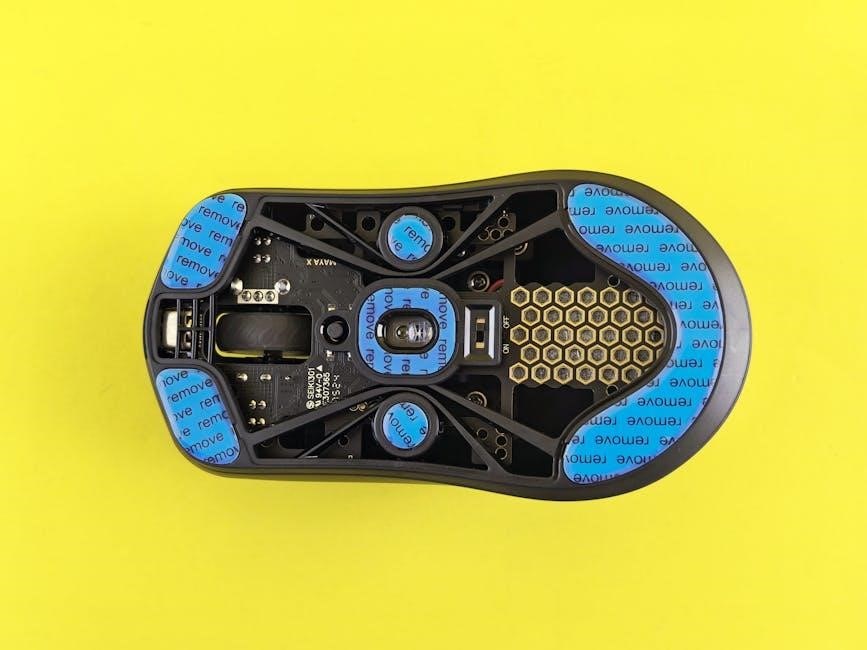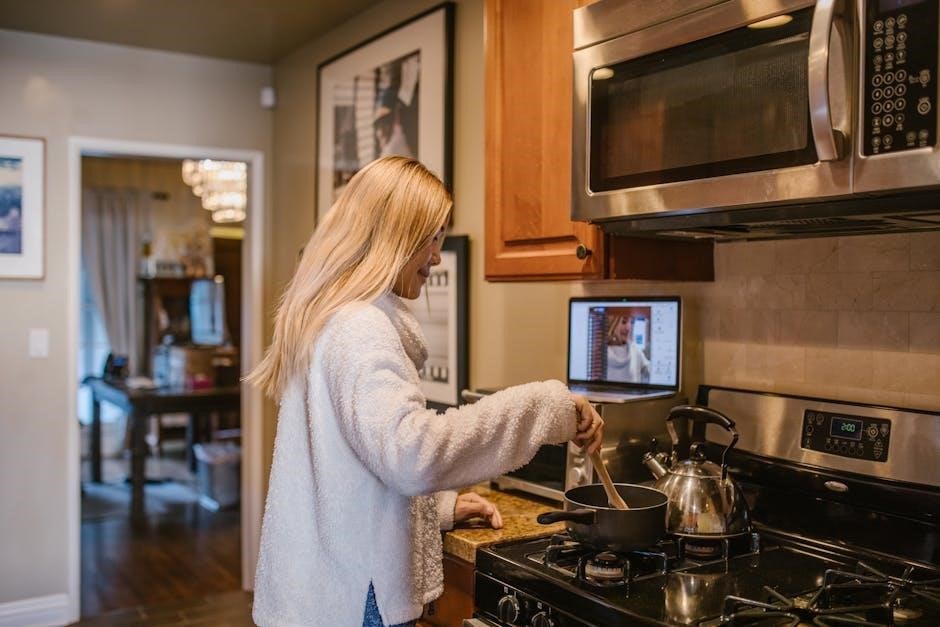The Kiinde Kozii Bottle Warmer is a safe, efficient, and easy-to-use device for warming breast milk, formula, and baby food. This guide provides step-by-step instructions to ensure proper use, safety, and maintenance of the Kiinde Kozii, helping parents warm their baby’s meals gently and effectively.
Overview of the Kiinde Kozii Bottle Warmer
The Kiinde Kozii Bottle Warmer is a versatile and innovative appliance designed to safely and efficiently warm breast milk, formula, and baby food. It features a universal design that accommodates various bottle types, bags, and food jars, making it a convenient solution for parents. With an expert-recommended temperature of 98°F and an auto-shutoff timer, the Kozii ensures gentle and consistent warming, preventing overheating and preserving nutrients. Its user-friendly interface and compact design make it an essential tool for everyday baby care.
Importance of Following the Instructions
Following the Kiinde Kozii instructions is crucial for safe and effective operation. Proper use ensures even heating, prevents overheating, and maintains the nutritional value of breast milk or formula. Deviating from guidelines can lead to unsafe temperatures or damage to the device. Always read the manual thoroughly before first use, and adhere to safety precautions to protect your baby and extend the product’s lifespan. Correct usage ensures optimal performance and peace of mind for parents.

Key Features of the Kiinde Kozii Bottle Warmer
The Kiinde Kozii features universal compatibility, expert-recommended 98°F temperature, auto-shutoff, and a large capacity. It gently warms breast milk, formula, and food jars while preserving nutrients.
Universal Compatibility with Bottles, Bags, and Jars
The Kiinde Kozii is designed to accommodate various bottle types, including glass, plastic, and breast milk storage bags. It also fits food jars, offering versatility for different feeding needs. This flexibility ensures parents can warm breast milk, formula, or baby food efficiently without needing multiple appliances. The large capacity of the Kozii makes it adaptable to different container sizes, providing a convenient solution for all warming requirements;
Expert-Recommended Warming Temperature (98°F)
The Kiinde Kozii warms to an expert-recommended 98°F, mimicking the natural temperature of breast milk. This ensures safe and gentle heating, preserving nutrients in breast milk and formula. The consistent temperature prevents overheating, making it ideal for sensitive baby food. With precise control, parents can trust the Kozii to maintain a healthy and safe temperature for their baby’s meals, promoting optimal nutrition and comfort.
Auto-Shutoff Timer for Safe Operation
The Kiinde Kozii features an auto-shutoff timer, ensuring safe operation by preventing overheating. Once the set time elapses, the warmer automatically turns off, maintaining the optimal temperature for baby’s food. This feature provides peace of mind for parents, eliminating the risk of overheated milk or food. The timer is easy to set, offering a convenient and reliable way to warm meals without constant supervision, making it a essential safety feature for busy parents.
Safety Precautions
Always read all instructions before using the Kiinde Kozii. Ensure safe temperatures for baby and supervise children closely during operation. Follow guidelines to prevent accidents.
Reading All Instructions Before Use
Reading all instructions before using the Kiinde Kozii Bottle Warmer is essential for safe and effective operation. The manual provides crucial information on setup, usage, and troubleshooting. It ensures you understand how to properly insert bottles, set timers, and maintain safe temperatures. Following the guidelines helps prevent accidents and ensures optimal performance. The instructions also include a warming time chart and safety precautions to protect your baby. Always refer to the manual before first use to guarantee the best experience for you and your baby.
Ensuring Safe Temperatures for Baby
The Kiinde Kozii Bottle Warmer is designed to heat breast milk, formula, and baby food to 98°F, mimicking body temperature. Always use the included warming time chart to avoid overheating. Before feeding, check the temperature by shaking the bottle and testing a few drops on your wrist. Avoid using boiling water, as it can damage nutrients and harm your baby. Ensure the water level stays above the “EMPTY” mark to prevent hot spots and maintain even heating. This ensures meals are safe and nutritious for your baby.
Close Supervision Around Children
Always supervise the Kiinde Kozii Bottle Warmer when in use, especially around children. Keep the warmer out of your baby’s reach to prevent accidental burns or injuries. Never leave a child unattended while the device is operating. Ensure the warming chamber is securely placed on a stable surface to avoid tipping. Teach older children to stay away from the warmer while it’s in use. This ensures a safe environment and prevents any potential hazards associated with the device.

Setting Up and Preparing the Kiinde Kozii
Unbox and inspect the Kiinde Kozii for damage. Familiarize yourself with the warming chamber and controls. Ensure the unit is placed on a stable, flat surface before first use.
Unboxing and Inspecting Components
Carefully unpack your Kiinde Kozii Bottle Warmer from its box. Inspect all components for any damage or defects. You should find the warmer unit itself, a power adapter, and an instruction manual. Ensure all parts are included and in good condition. Check for any visible damage, such as cracks or dents, which could affect performance. If any components are damaged or missing, contact the manufacturer immediately. Proper inspection ensures safe and effective use of the Kiinde Kozii.
- Warmer unit
- Power adapter
- Instruction manual
Understanding the Warming Chamber and Controls
The Kiinde Kozii Bottle Warmer features a large, versatile warming chamber designed to accommodate bottles, breast milk bags, and food jars. The control dial allows you to set the desired warming time, while the auto-shutoff timer ensures safe operation by turning off the unit once the cycle is complete. The water level indicator helps maintain the correct amount of water for efficient warming. The chamber is designed for gentle, even heating, preserving nutrients in breast milk and formula. Familiarizing yourself with these components ensures optimal performance and safety.

Operating the Kiinde Kozii Bottle Warmer
Insert the bottle, bag, or food jar into the warming chamber, set the timer using the provided warming time chart, and monitor the process to ensure safe and effective warming.
Inserting the Bottle, Bag, or Food Jar
Ensure the Kiinde Kozii is ready for use. Place the bottle, bag, or food jar into the warming chamber, centering it to maintain balance. Avoid overfilling the container, as this may lead to spills during warming. If using a bag, secure it properly to prevent movement. Always check the water level in the chamber before inserting the item. Use the overflow drain if necessary to remove excess water. This ensures safe and even warming. Set the timer according to the warming time chart for optimal results.
Setting the Timer and Using the Warming Time Chart
Locate the timer dial on the Kiinde Kozii and set it according to the warming time chart provided. The chart estimates warming times based on the container type (bottle, bag, or jar) and starting temperature. Turn the dial to the recommended time, ensuring precise control. Once set, the unit will automatically shut off, preventing overheating. Use the chart as a guide to achieve the perfect temperature for your baby’s meal. This feature ensures safe and efficient warming every time.
Monitoring the Warming Process
Always monitor the warming process to ensure safety and efficiency. Check the timer periodically to track progress. Visually inspect the contents through the transparent design to avoid overheating. Ensure the unit does not overheat by maintaining the recommended water level. Never open the warmer during operation. Once the timer goes off, carefully remove the bottle, bag, or jar and check the temperature before feeding your baby. Proper monitoring ensures a safe and optimal warming experience for your baby’s meal.

Cleaning and Maintaining the Kiinde Kozii
Regularly drain water from the warming chamber and clean it with mild soap. Rinse thoroughly to ensure hygiene and prevent mineral buildup for optimal performance.
Draining and Cleaning the Warming Chamber
Regularly drain water from the warming chamber using the overflow drain hole at the top and back. Mix 1 cup of mild soap with warm water, then pour into the chamber. Scrub gently if needed to remove residue. Rinse thoroughly with clean water to ensure no soap remains. Allow the chamber to dry completely after cleaning to prevent mineral buildup and maintain hygiene. This process ensures optimal performance and safety for your baby.
Sanitizing the Unit for Optimal Hygiene
Sanitize the Kiinde Kozii by mixing equal parts water and white vinegar. Pour the solution into the warming chamber and let it sit for 5-10 minutes. Scrub gently with a soft brush to remove any residue. Rinse thoroughly with clean water to eliminate any vinegar taste or smell. Regular sanitizing ensures the removal of bacteria and maintains a hygienic environment for warming baby food and milk, promoting your baby’s health and safety.
Troubleshooting Common Issues
Check water levels and ensure proper drainage. Verify timer settings and heating times. Descale the unit if mineral buildup occurs. Refer to the manual for detailed solutions.
Resolving Heating Time or Temperature Concerns
If the Kiinde Kozii isn’t heating as expected, ensure the water level is above the minimum mark. Check the timer setting and refer to the warming time chart for guidance. For temperature concerns, verify that the unit is set correctly and not overheating. Descale regularly to maintain efficiency. If issues persist, reset the device or consult the troubleshooting section in the manual for further assistance and solutions.
Addressing Water Level and Drainage Issues
Ensure the water level in the Kiinde Kozii is above the minimum mark to prevent overheating. If water flows from the overflow drain, pour out excess until the level is correct. After use, drain the chamber using the overflow hole and rinse thoroughly. Proper water levels and drainage are crucial for efficient heating and safety. Regularly cleaning and descaling the unit can also resolve water-related issues and maintain optimal performance over time.


























































